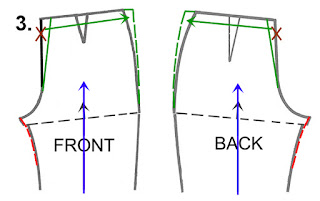www.SureFitDesigns.com
Many of you have asked for the actual video directions for developing and drawing the Men's Pants pattern. The good news is they're now available. In these video lessons, you'll see lot of great close-ups which totally remove the guesswork when drawing both the men's pants back and front patterns.
These lessons are free for you if you already own the Men's Pants Instructional Package. Those of you who bought this item individually or had it included with a Men's Combo or Works Combo, will have access to these video lessons totally free. Simply contact your SFD distributor (see links below), provide proof of purchase or approximate date of purchase (so that we can cross-reference our files and your order), OR a photo of your Men's envelope, and the 100% Discount Code will be sent to you.
These lessons are now housed in our streaming video site: www.SewFitAcademyOnline.com.
To draw the men's pants pattern, you'll require both the ladies' Pants Kit and the Men's Pants Instructional Package. If you already own the Men's Pants Package, contact your distributor to receive the 100% Discount Code giving you totally free access to these new video lessons.
www.SewFitAcademyOnline.com
Don't let yourself get 'fit to be tied!' Eliminate any frustration. Just follow along with these new video lessons on drawing the men's pants. If you already own the Men's Pants Package, contact your distributor to receive the 100% Discount Code giving your totally free access to these new video lessons. Please provide proof of purchase or approximate date of purchase.
Enjoy!
Glenda the Good Stitch!
Many of you have asked for the actual video directions for developing and drawing the Men's Pants pattern. The good news is they're now available. In these video lessons, you'll see lot of great close-ups which totally remove the guesswork when drawing both the men's pants back and front patterns.
These lessons are free for you if you already own the Men's Pants Instructional Package. Those of you who bought this item individually or had it included with a Men's Combo or Works Combo, will have access to these video lessons totally free. Simply contact your SFD distributor (see links below), provide proof of purchase or approximate date of purchase (so that we can cross-reference our files and your order), OR a photo of your Men's envelope, and the 100% Discount Code will be sent to you.
These lessons are now housed in our streaming video site: www.SewFitAcademyOnline.com.
To draw the men's pants pattern, you'll require both the ladies' Pants Kit and the Men's Pants Instructional Package. If you already own the Men's Pants Package, contact your distributor to receive the 100% Discount Code giving you totally free access to these new video lessons.
www.SewFitAcademyOnline.com
Don't let yourself get 'fit to be tied!' Eliminate any frustration. Just follow along with these new video lessons on drawing the men's pants. If you already own the Men's Pants Package, contact your distributor to receive the 100% Discount Code giving your totally free access to these new video lessons. Please provide proof of purchase or approximate date of purchase.
Your SFD Distributors:
South Africa - Contact:
Elsabe Hurn - elsabe@surefitdesigns.co.za
UK/Ireland/EU
- Contact: Judith Johnson - info@surefitdesigns.co.uk
Canada - Contact: Anna
Espindola - anna@surefitdesigns.ca
Australia/NZ - Contact: Martha Schuster - martha@surefitdesigns.com.auEnjoy!
Glenda the Good Stitch!
























